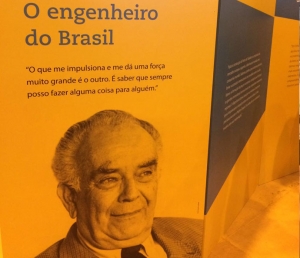


(Posted on 21/06/18)
With immense sadness, Vale has announced the passing of Eliezer Batista, the first person to hold the main position within the company. A two-time president of what was then, Companhia Vale do Rio Doce, Eliezer laid the ground work for the growth that would take place from the 1980s onwards, creating a long-term and large-volume ore marketing strategy with Japanese steelmakers.
In his first reign as president from 1961 to 1964, to support the planned growth, Eliezer planned the Port of Tubarão, in the state of Espírito Santo, as there was a need for a port capable of receiving vessels of up to 150,000 tons - although most of world’s fleet did not exceed 60,000 tons. This innovative idea enabled Vale to double the volume of its exports. During this period, Eliezer was also Minister of Mines and Energy (1962-1964), holding both positions.
Eliezer Batista was appointed by President Jânio Quadros at age 36, position he held from 1961 to 1964. In 1962, Vale signed the first long-term contracts with 10 Japanese steel mills, to supply 50 million tons of iron ore for a period of 15 years. In return, the Japanese helped build Tubarão. Eliezer's vision was interrupted by the Military Coup where he was accused of being a communist. He lived with this accusation for a number of years and was ultimately dismissed from the presidency of Vale
The engineer from the small mining town of Nova Era, Minas Gerais, would only return to Vale in 1979. His main challenge: to implement the Carajás Project, in the middle of the Amazon jungle. National money was scarce and the second Oil Crisis was knocking on the door. Eliezer did not give up and three times went to the World Bank for a loan and even managed to convince the bank's almost unbreakable chairman, Robert MacNamara, a former US Secretary of Defense in the governments of John Kennedy and Lindon Johnson.
Carajás was budgeted at US$4.2 billion. But, thanks to the organization and the sense of public responsibility of those involved in the project, all the planned projects - mine, railroad and port, in addition to all the increase in social and infrastructure areas – cost US$ 2.8 billion. Everything was delivered within the agreed timescales.
In 1986, Eliezer left his presidency of Vale. Thirty years later, in 2016, he would lend his name to the largest project in the history of world mining: the S11D Eliezer Batista Complex, the first iron mine built with the least possible environmental impact in mind; without trucks, allowing for a 70% reduction in diesel consumption.
“Today, we are sad. Our greatest engineer, the man to whom we owe practically everything to, has gone. Eliezer Batista, who once earned the nickname "Engineer of Brazil", could also be known by another nickname: "the Builder of Vale". Yes, we are proud to say that we were his main work. And he, in turn, was Vale's work.” said Vale's CEO Fabio Schvartsman.
ADM and Mitsubishi Corporation have signed a non-binding memorandum of understanding to form a strategic... Read more
ESL Shipping and global steel manufacturer SSAB have agreed on a multi-year extension of the agreement... Read more
Anglo American’s Sakatti copper and polymetallic project in Finland has been designated as a &... Read more
FEFAC, representing the EU compound feed and premix manufacturers, noted with deep concern the announced... Read more
Catering to the growing demand from India’s confectionery, infant formula, and dairy sectors,... Read more
Khalifa Economic Zones Abu Dhabi – KEZAD Group, the largest operator of integrated and purpose... Read more
Rio Tinto will invest $1.8 billion1 to develop the Brockman Syncline 1 mine project (BS1), extending... Read more
Catherine Cobden, President and CEO of the Canadian Steel Producers Association (CSPA), has released... Read more
Enough domestic ferrous scrap is available for electric arc furnace (EAF) steelmakers to supply nearly... Read more
Cargill’s Ocean Transportation business and leading tanker shipping company, Hafnia, have joined... Read more